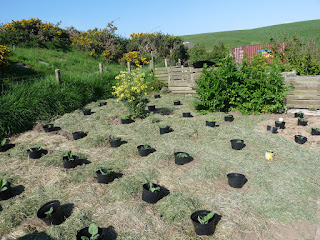 |
| Mulched potatoes |
Mulching has several benefits:
- It suppresses weeds.
- It retains moisture.
- It provides a slow-release fertiliser.
 |
| Mulch around the brassicas and squashes |
After earthing up the potatoes once we put a thick mulch around the plants; this is topped up regularly to keep those tubers well covered.
Elsewhere in the veg garden, we mulch around all the bigger plants that are well spaced out - all the brassicas, squashes, artichokes, sweet corn and celeriacs etc. - and inside the wigwams for beans and peas. It's not practical to use mulch around smaller, tightly spaced plants such as onions, carrots and beetroot - so more weeding is necessary there, sadly.
Mulch is also useful if you want to prepare an area for planting the following year and kill off the weeds in it. For larger areas we use black plastic covers, but for inconveniently shaped areas, maybe with plants already in it that you'd like to keep, mulch is the easiest.
Simply the best way to get rid of all those grass clippings!
No comments:
Post a Comment
Comments and questions are welcome.
If you've tried something after reading about it here, or have suggestions, please tell us about it!